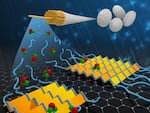
Individual silk protein molecules, or “silk fibroins” (blue), are deposited on a graphene surface surrounded by water (green and red spheres). This precise layering of silk fibers could lead to numerous biodegradable electronic devices.
Courtesy of Mike Perkins, Pacific Northwest National Laboratory)
Nature was onto something when it made silk: It’s stronger than kevlar, flexible and stretchable. And scientists and manufacturers have been working for years to tap into these mechanical properties to create all manner of products, including electronics.
But if you look at silk really closely, you’d see the proteins inside form a fuzzy, wooly tangle. This limits how the material can be used.
Now researchers at Pacific Northwest National Lab and the University of Washington have figured out a way to detangle the proteins, opening the door for new kinds of silk-based electronics, including transistors and memristors.
The researchers developed a way to coax silk proteins to line up in neat and tidy rows on sheets of graphene. The resulting material is about a quarter the thickness of a strand of DNA, so would be suitable for developing extremely small-scale circuits.
Silk-based electronics have the added benefit of being biodegradable and biocompatible, meaning they have the potential for use in the human body.
The research is published in Science Advances and can be read here.

This microscope image shows silk fibroin uniformly self-assembling on graphene. These straight lines of silk proteins open the door for harnessing the useful physical properties of silk in tiny electrical circuits.
Courtesy of James De Yoreo, Pacific Northwest National Laboratory
In these https://www.opb.org/show/all-science-no-fiction/, “All Science. No Fiction.” creator Jes Burns features the most interesting, wondrous and hopeful science coming out of the Pacific Northwest.
And remember: Science builds on the science that came before. No one study tells the whole story.
